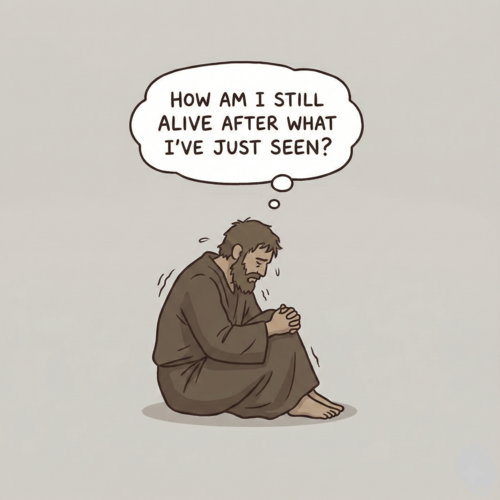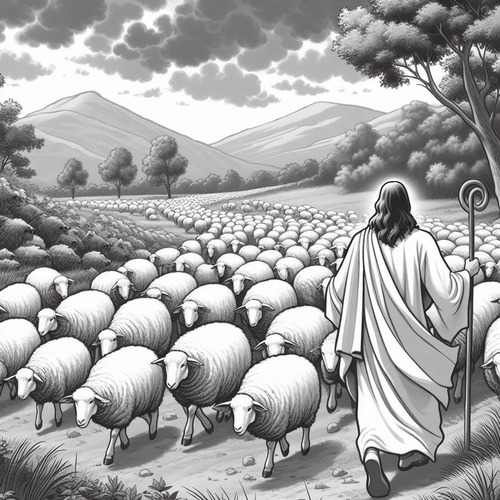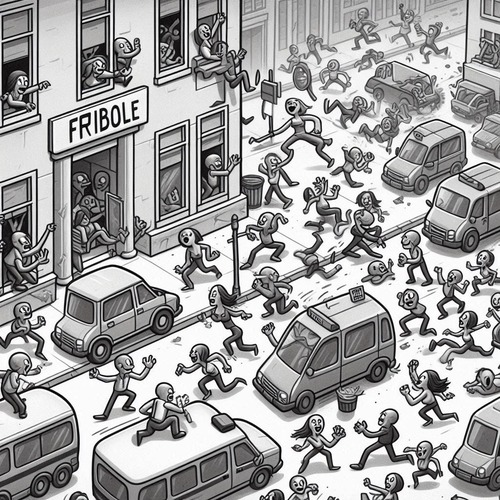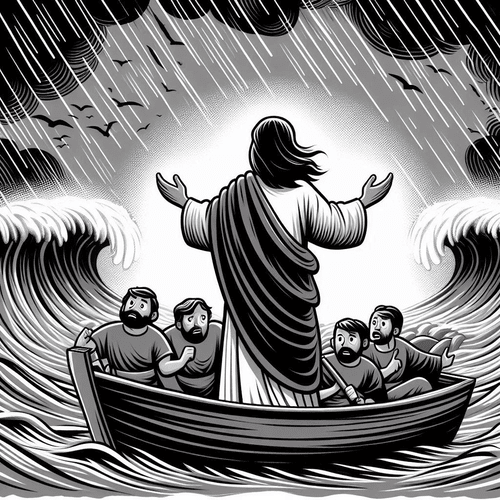Will a Loving God Allow Violence? Insights from the Old Testament
In the Old Testament, we encounter stories of divine judgement, holy wars, and capital punishment that can leave modern readers perplexed and troubled. Can we reconcile these accounts of violence with the God of love the New Testament proclaims? This question has challenged believers and skeptics alike for centuries. Let’s explore this difficult topic, seeking to understand Old Testament violence within the broader context of God’s nature and His redemptive plan for humanity.
Understanding God’s Nature: To grapple with the issue of violence in the Old Testament, we must first understand the nature of God as revealed in Scripture. Our God is not one-dimensional, but a complex being of infinite perfection.
- God’s holiness and justice: Scripture consistently portrays God as utterly holy and perfectly just (Isaiah 6:3, Psalm 89:14). His holiness demands separation from sin, and His justice requires that sin be punished.
- God’s love and mercy: Alongside His holiness and justice, God is also described as loving, compassionate, and merciful (Exodus 34:6-7, 1 John 4:8).
- The harmony of God’s attributes: These attributes are not in conflict but in perfect harmony. God’s love does not negate His justice, nor does His justice diminish His love.
Understanding this multifaceted nature of God is crucial as we approach the difficult passages of the Old Testament.
The Context of Old Testament Violence: To properly interpret the violent passages in the Old Testament, we must consider their historical and theological context:
- The fallen nature of humanity: After the Fall, human beings became inherently sinful, constantly rebelling against God’s rule (Genesis 6:5, Romans 3:23).
- God’s covenant with Israel: God chose Israel to be His special people, through whom He would ultimately bring salvation to the world (Genesis 12:1-3, Deuteronomy 7:6-8).
- The spiritual warfare against idolatry and wickedness: Much of the violence in the Old Testament occurs in the context of Israel’s struggle against the idolatrous and often horrifically wicked practices of surrounding nations (Deuteronomy 12:29-31, 18:9-12).
Types of Violence in the Old Testament: The violence we encounter in the Old Testament generally falls into three categories:
- Divine judgment: Examples include the Flood (Genesis 6-8) and the destruction of Sodom and Gomorrah (Genesis 19).
- Holy war: This primarily refers to the conquest of Canaan under Joshua’s leadership (Joshua 6-12).
- Capital punishment in Israelite law: The Mosaic Law prescribed death for certain severe offenses (e.g., Exodus 21:12-17).
Theological Explanations: While these accounts can be disturbing, there are several important theological principles to consider:
- God’s sovereignty over life and death: As the Creator, God has the right to give and take life (Deuteronomy 32:39, 1 Samuel 2:6).
- The reality of divine judgement: God’s judgement against sin is a recurring theme throughout Scripture, culminating in the final judgment (Revelation 20:11-15).
- Protection and preservation of God’s covenant people: Many instances of violence involve God protecting Israel from corruption or destruction, preserving the line through which the Messiah would come.
- Foreshadowing of ultimate judgement and salvation: Old Testament judgements point to the final judgment and highlight the need for salvation through Christ.
Challenging Common Objections: Critics often raise several objections to the violence in the Old Testament:
- Claims of divine “genocide”: It’s crucial to understand God’s commands for destruction were specific, limited in time and scope, and based on extreme wickedness, not ethnic identity.
- The concept of corporate responsibility: In the ancient Near East, individuals were seen as part of a larger community. God’s judgements often reflected this cultural understanding.
- Descriptive vs. prescriptive passages: Many violent passages describe historical events rather than prescribe behaviour for all time.
The Big Picture: God’s Redemptive Plan: To fully grasp the significance of Old Testament violence, we must view it within the larger context of God’s redemptive plan for humanity.
- Christ’s sacrifice: The violence of the Old Testament ultimately points to the violence Christ endured on our behalf (Isaiah 53:5, Romans 5:8). The graphic nature of Old Testament judgement foreshadows the ultimate act of divine judgement: Christ’s crucifixion. On the cross, Jesus bore the full weight of God’s wrath against sin. This supreme act of sacrificial love demonstrates that God does not take sin or judgement lightly, but was willing to bear it Himself to secure our salvation. The Old Testament sacrificial system, with its bloody rituals, pointed forward to this perfect, final sacrifice.
- Progressive revelation: God’s revelation progresses throughout Scripture, culminating in the person and work of Jesus Christ (Hebrews 1:1-2). God’s self-disclosure to humanity has been gradual and progressive. The Old Testament provides the foundation for understanding God’s holiness, justice, and the seriousness of sin. In the New Testament, particularly in Jesus Christ, we see the fullest revelation of God’s nature and plans. This progression helps us see the violent passages of the Old Testament are not God’s final word, but part of a larger narrative leading to Christ. They highlight the gravity of sin and the costliness of grace, preparing the way for the full revelation of God’s love in Jesus.
- God’s ultimate goal: Despite the violence, God’s ultimate goal is the restoration of all things and eternal peace (Revelation 21:1-4). The judgments in the Old Testament serve God’s greater purpose of establishing His kingdom – a realm of perfect peace and justice. These acts of judgment point forward to the final judgement, after which God will establish the new heavens and new earth. In Revelation 21:1-4, we see a picture of this ultimate goal: a world without sin, suffering, or death, where God dwells with His people in perfect fellowship. This vision contextualizes Old Testament violence, showing it as a necessary step towards complete restoration, not God’s final intention.
By understanding these aspects of God’s redemptive plan, we can see the Old Testament’s violent passages as integral parts of a grand narrative. This narrative moves from creation through fall and redemption, culminating in the final restoration of all things through Christ. The violence, while difficult, underscores the seriousness of sin, the cost of redemption, and the magnificence of God’s saving grace.
God’s Mercy and Patience in Judgment: As we grapple with the violence in the Old Testament, it’s crucial we don’t lose sight of God’s mercy and patience, which are abundantly evident even in the context of judgement.
- God’s patience before judgement: Throughout the Old Testament, we see God often delays judgement, giving people time to repent. Before the Flood, God waited while Noah built the ark (1 Peter 3:20). Before destroying Sodom and Gomorrah, God was willing to spare the cities for the sake of a few righteous people (Genesis 18:16-33). God gave the Canaanites centuries to repent before bringing judgement through Israel (Genesis 15:16).
- Mercy interwoven with judgement: Even in acts of judgement, we often see God’s mercy at work. During the Exodus plagues, God gave multiple warnings and opportunities for Pharaoh to repent. In the conquest of Canaan, God spared Rahab and her family because of her faith (Joshua 2, 6:22-25). The book of Judges shows a repeated cycle of God judging Israel’s sin, but then mercifully delivering them when they cried out to Him.
- God’s compassion for the nations: While much of the Old Testament focuses on Israel, we see glimpses of God’s concern for other nations as well. The book of Jonah powerfully illustrates God’s desire to show mercy to the Ninevites, much to Jonah’s frustration. The prophets often spoke of God’s future plans to bless all nations (Isaiah 19:23-25, Amos 9:7).
- The coexistence of justice and mercy: The Old Testament doesn’t shy away from depicting the tension between God’s justice and His mercy. This tension finds its ultimate resolution in the cross of Christ, where God’s judgment against sin and His merciful love for sinners meet (Romans 3:23-26).
- God’s unchanging character: The mercy we see in the New Testament isn’t a change in God’s character, but a fuller revelation of who He has always been. Even in the midst of proclaiming judgment, God declares, “I take no pleasure in the death of the wicked, but rather that they turn from their ways and live” (Ezekiel 33:11)
Conclusion: The violence in the Old Testament presents a challenging theological issue, but it’s one we must face honestly. By understanding God’s multifaceted nature, the historical and theological context, and the broader scope of God’s redemptive plan, we can begin to make sense of these difficult passages.
Ultimately, the Old Testament’s violent episodes serve to highlight the severity of sin, the reality of divine judgment, and the incredible mercy of God in providing salvation through Jesus Christ. As we grapple with these texts, may we be driven to a deeper appreciation of God’s holiness, a more profound gratitude for His grace, and a greater commitment to the gospel that offers redemption to all who believe.
Related FAQs
- Why did God send a flood to destroy almost all of humanity (Genesis 6-9)? The Flood was God’s response to humanity’s total moral corruption, which threatened His plan for redemption. It demonstrates the seriousness of sin and its consequences, while also showing God’s mercy in preserving Noah’s family. The Flood serves as a type of the final judgement and the salvation God provides through Christ, our ark.
- How can we justify God’s destruction of Sodom and Gomorrah (Genesis 19)? The destruction of Sodom and Gomorrah illustrates God’s judgement against extreme wickedness that had corrupted an entire society. God demonstrated His mercy by being willing to spare the cities for just ten righteous people and by rescuing Lot’s family. This event serves as a warning about the reality of divine judgement and the need for repentance.
- How do we reconcile the violent conquest of Canaan (Joshua 6-12) with a loving God? The conquest of Canaan was God’s judgement on the Canaanites’ centuries of detestable practices and His means of fulfilling promises to Israel. It was necessary to protect Israel from moral and spiritual corruption, preserving the line through which salvation would come to the world. This event foreshadows Christ’s victory over evil and the establishment of God’s kingdom.
- Why did God command the destruction of the Amalekites (1 Samuel 15)? God’s command to destroy the Amalekites was a response to their long history of opposing God’s people and the ongoing threat they posed. This specific command demonstrates the seriousness of persistent rebellion against God and His purposes. It highlights the reality of God’s judgment against those who consistently oppose His will and harm His people.
- Were the plagues of Egypt (Exodus 7-12) an excessive display of God’s power? The plagues of Egypt served to demonstrate God’s power over the Egyptian gods, discrediting the pagan pantheon. Each plague gave Pharaoh an opportunity to repent, showing God’s patience. They culminated in the Passover, foreshadowing Christ’s sacrificial death and setting the stage for Israel’s redemption.
- Has God changed between the Old and New Testaments? God’s essential nature has not changed; His love, mercy, and patience are evident throughout the Old Testament, while the New Testament also speaks of His wrath and judgment. The difference lies not in God’s nature but in the unfolding of His redemptive plan. The Old Testament laid the groundwork for understanding sin and judgment, which find their fulfillment in Christ in the New Testament.
- Why did God see violence as necessary in the Old Testament? God’s use of violence in the Old Testament served to judge sin, protect His people, and reveal His character. It demonstrated the seriousness of sin and its consequences, while also foreshadowing Christ’s work on the cross. These acts were part of God’s larger plan to deal with sin, establish His kingdom, and bring about ultimate redemption through Christ.
Related Posts:
Editor's Pick

The Throne-Room Vision: Who Did Isaiah See?
The scene is unforgettable: Isaiah stands in the temple, and suddenly the veil between heaven and earth tears open. He [...]

The Angel of the Lord: Can We Be Certain It Was Christ All Along?
Throughout the Old Testament, a mysterious figure appears: the Angel of the LORD. He speaks as God, bears God’s name, [...]
SUPPORT US:
Feel the Holy Spirit's gentle nudge to partner with us?
Donate Online:
Account Name: TRUTHS TO DIE FOR FOUNDATION
Account Number: 10243565459
Bank IFSC: IDFB0043391
Bank Name: IDFC FIRST BANK






